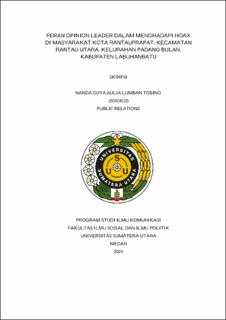| dc.description.abstract | This research is titled "The Role of Opinion Leaders in Dealing with Hoaxes in the Community of Rantauprapat City, North Rantau Subdistrict, Padang Bulan Village, Labuhanbatu Regency." The purpose of this research is to understand the role of opinion leaders in addressing hoaxes in the community of Rantauprapat City, North Rantau Subdistrict, Padang Bulan Village, Labuhanbatu Regency, and to determine how the public can differentiate between true news and false news (hoaxes). The theories used in this research are mass communication, the multi-step flow communication model, group communication, opinion leaders, and the community. The research method used is qualitative descriptive. The primary informant in this research is an opinion leader, and the triangulation informants are the residents of Rantauprapat City, North Rantau Subdistrict, Padang Bulan Village, Labuhanbatu Regency. The informants were selected using purposive sampling techniques. Data in the research were obtained through interviews, observations, and documentation. Data validity was achieved using triangulation techniques. The results of this research indicate that the role of opinion leaders includes seeking the truth of a news story, sharing verified news, responding to and handling hoaxes, collaborating with authorities to provide education and guidance on dealing with hoaxes, informing the public about the characteristics of hoaxes, setting a positive example for the community, and actively participating in information screening and driving change, promoting specific public policies, or even joining social movements. Furthermore, opinion leaders should also be a source of information and knowledge for the community. The research also shows that the public can distinguish between real news and hoaxes by examining their sources, identifying provocative or discriminatory language containing elements of identity-based conflict, analyzing information, verifying and evaluating information, scrutinizing headlines, and examining whether videos or photos appear to be edited. | en_US |




